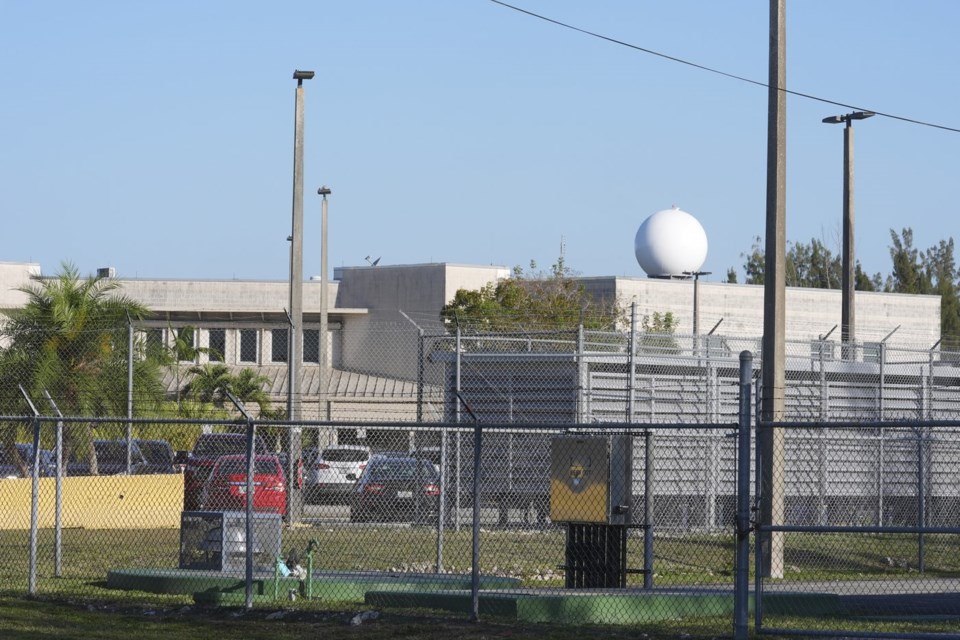MIAMI (AP) — As hundreds of migrants crowded into the Krome Detention Center in Miami on the edge of the Florida Everglades, a palpable fear of an uprising set in among its staff.
As President Donald Trump sought to make good on his campaign pledge of mass arrests and removals of migrants, Krome, the United States' oldest immigration detention facility and one with a long history of abuse, saw its prisoner population recently swell to nearly three times its capacity of 600.
“There are 1700 people here at Krome!!!!,” one U.S. Immigration and Customs Enforcement employee texted a co-worker last month, adding that even though it felt unsafe to walk around the facility nobody was willing to speak out.
That tension comes amid a battle in federal courts over whether the president’s immigration crackdown has gone too far, too fast at the expense of fundamental rights.
At Krome, reports have poured in about a lack of water and food, unsanitary confinement and medical neglect. With the surge of complaints, the Trump administration shut down three Department of Homeland Security oversight offices charged with investigating such claims.
A copy of the text exchange was shared with The Associated Press by a federal employee on the condition of anonymity for fear of retaliation. Other documents include detainee complaints as well as an account of the arrival of 40 women at Krome, an all-male facility, in possible violation of a federal law to reduce the risk of prison rape.
Nationwide, detentions have surged to nearly 48,000 as of March 23, a 21% increase from the already elevated levels at the end of the Biden administration.
To address the shortage of capacity, ICE this month published a request for bids to operate detention centers for up to $45 billion as it seeks to expand to 100,000 beds from its current budget for about 41,000. As part of the build out, the federal government, for the first time, is looking to hold migrants on U.S. Army bases.
By some measures, Trump's controversial approach is working. Barely 11,000 migrants were encountered at the U.S.-Mexican border in March, their lowest level in at least a decade and down from 96,035 in December 2024, according to U.S. Customs and Border Protection.
Krome is just one of five facilities that ICE directly runs and can house detainees for more than 16 hours. The vast majority of bed space is leased from local prisons, jails or privately-run facilities that have strict limits on how many detainees they are contractually obligated to accept.
As its concrete cellblocks began filling up, federal workers started documenting the worsening conditions in weekly reports for DHS leadership. They worked their way up the chain through DHS’ Office of Immigration & Detention Ombudsman, an independent watchdog established by Congress during the first Trump administration.
In mid-March, the office’s 100 staffers — including a case manager at Krome — were placed on administrative leave.
“Rather than supporting law enforcement efforts, they often function as internal adversaries that slow down operations,” DHS spokeswoman Tricia McLaughlin said at the time.
Around the same time, Krome’s chaos spilled into public view. Images secretly shot on a cellphone and posted on TikTok showed a group of men sleeping on concrete floors and under tables with little more than their shoes as pillows.
“We are practically kidnapped,” Osiris Vazquez, his eyes bloodshot due to a lack of sleep, said in the grainy video, which garnered 4.4 million views. “We don’t want likes. We want help. Please!”
Vazquez said he shared a small room for two weeks with some 80 men. Showers and phone calls weren’t allowed, the fetid-smelling bathrooms were left unattended and food was restricted to peanut butter sandwiches.
“You lost all notion of time, whether it’s day or night," recalled Vazquez in an interview after self-deporting to his native Mexico.
It could’ve been worse. Since Trump returned to the White House, three detainees have died in ICE custody — two of them at Krome.
The latest, Maksym Chernyak, died after complaining to his wife about overcrowding and freezing conditions. The 44-year-old Ukrainian entered the U.S. last year under a humanitarian program for people fleeing the country’s war with Russia.
He was sent to Krome after an arrest for domestic violence and got sick with a chest cold. After being monitored for a week with high blood pressure, on Feb. 18, at 2:33 a.m., he was taken to a hospital for seizure-like vomiting. Two days later, he died.
Other than acetaminophen, he received no medication to treat his blood pressure, according to a two-page ICE report about Chernyak’s death. Chernyak’s widow said that before her husband’s detention, he was a “strong, healthy man.” Without a translator, she said, her husband struggled to communicate.
“They saw his condition, but they ignored him,” said Oksana Tarasiuk in an interview. “If he wasn’t put in Krome, I’m sure that he would still be alive.”
ICE, in a statement, didn’t comment on specific allegations of mistreatment but said it adjusts its operations as needed to uphold its duty to treat individuals with dignity and respect.
“These allegations are not in keeping with ICE policies, practices and standards of care,” the agency said.
Krome housed 740 men and one woman on March 31, according to the latest ICE data. That’s up 31% from just before Trump took office. ICE refused to disclose Krome’s current capacity because of security concerns.
—
AP Writers Michael Sisak in New York and Rebecca Santana in Washington contributed to this report.
Joshua Goodman And Gisela Salomon, The Associated Press


